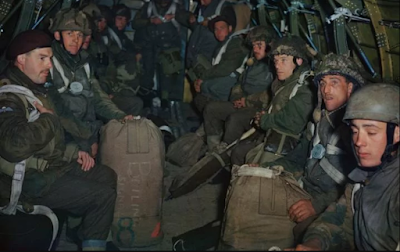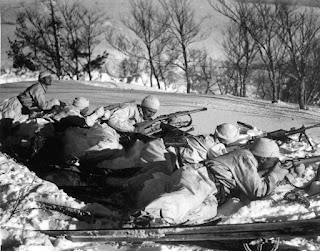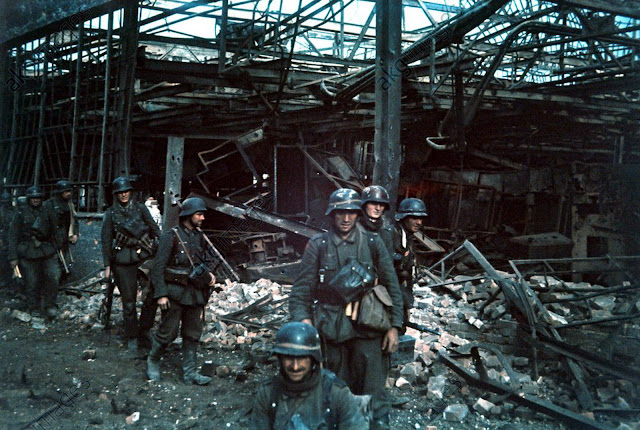Newbie Do - Voice with Boards (VWB)
K, the following post was made by my erstwhile opponent FargoGamer way back in the depths of 2013. Since it is disappearing from search engines I have reproduced it here as it gives an excellent description of how to play ASL online without VASL. I will try and take some replacement setup photos when I next play as the images have all gone.
This guide explains how to play ASL over the Internet using all those real maps and counters you paid good money for. Many players think VASL is the defacto way to play ASL online but I strongly urge you and your friends to try this method instead. It’s far less hassle than it might appear and is, in my opinion, a vastly more rewarding and intimate way to play ASL online when local f2f isn’t available.

In the thick of battle playing Crossing the Bloody Meadow!
So what’s the point – why not just use VASL?
My initial motivation for trying this method was simply a desire to interact with the cardboard I’d spend hundreds of pounds buying and organising. On top of this was a need to limit the amount of time I spent exposed to bright LCD computer screens, especially during my leisure time. Working with computers all day made sitting down at home to play in front of a laptop seem more like an extension of work than a fun hobby. I also quickly tired of the constant zooming and scrolling required to play larger scenarios over VASL. Being able to sit in front of the real boards and survey the whole battlefield is a great feeling compared to the constraints of a computer screen. Another reason was to escape the soulless dice bot. For me one of the fun things about traditional wargaming is the excitement of the dice clattering on the tabletop.
So what do I need to play like this?
it’s really pretty straightforward.
- An opponent
- A skype, google hangout or similar VOIP account
- A proper table surface to play on
- A place to store your games between sessions
- (Optional) A webcam to view your opponent’s dice or beautiful face
Here’s a picture of my viewing setup. The webcam is a 10 dollar one perched on a small box to get a nice angle on the dice tower.
 My Cardboard ASL online setup with a cheap webcam acting as dice-cam and laptop for speech/sound
My Cardboard ASL online setup with a cheap webcam acting as dice-cam and laptop for speech/sound
And this is my mid-game storage solution…stacked perspex picture frames. The boards are positioned underneath the perspex and the counters placed on top. Everything gets stowed on top of a wardrobe out of harms way. With this method I can have several ASL games going at one time.
It’s a good idea to find space to store games in progress so you don’t have to setup positions every session
The basic method of play
The concept is very simple. You and your opponent set up the boards and OOB for your chosen scenario, then announce (or email ahead of time) the starting locations of your respective units (adhering to normal attacker/defender and on/off-board concealment and HIP considerations). During live play each player announces his actions, moving his own pieces and his opponents as play commences. Simple!
It’s a good idea to announce moves clearly and consistently, giving your opponent plenty of time to update the board on his end. Referencing the hex co-ordinates is always a good way to keep things clear. eg: ‘The squad with LMG in E4 will assault move to E5′ or ‘The Mortar in L2 with 8-1 leader will fire at your units in X3‘. Equally, try and avoid informal announcements as more often than not your opponent won’t immediately know what you’re talking about. eg: ‘Ok, my Stug is firing back at your pesky 9-2 stack!’ or ‘I’m going to try and repair my HMG again’. Make a habit of referencing those hex co-ordinates.
If there’s a good rapport between players then seldom, if ever, do pieces get out of sync or put in the wrong location. Any mishaps are just as quickly resolved as in a ftf situation. Some players may elect to point a webcam at their board to help the validation process but believe me this isn’t necessary. The process is no more problematic than announcing a chess move over the telephone.
Please refer to the Example of Play section at the end of this post for a more detailed simulation of play.
What are the advantages of playing this way?
Some of this I’ve already covered in the introduction but here’s a more comprehensive list:
- You get to use the real game components
- No more VASL scrolling and zooming
- It gets you away from those unhealthy computer screens
- HIP units, mines and entrenchments can be placed on your board so you don’t forget
- No VASL server downtime
- No DICE bots
- It’s great training for using the cardboard in tournaments if you have limited local f2f.
- It encourages more MMP sales because both players need the material to play.
Special circumstances and FAQs
Here’s some common questions and answers about this method of play.
How does HIP work?
HIP works great using this method. Because your opponent cannot see your board you can safely place all your HIP units and Guns onboard. When it comes time to reveal them you simply inform your opponent. This ability to place hidden units is a godsend when playing scenarios with lots of mines and hidden defences. If you have trouble remembering which units are still HIP a simple solution is to rotate those units 90 degrees or simply mark them with a generic counter (a blank counter or upside-down ? marker are good choices)
How does Concealment work?
 Concealment stacks galore!
Concealment stacks galore!
Pretty much the same as normal. When you’re setting up dummy stacks or concealed stacks before play you simply tell your opponent how many counters are underneath the top ? counter. He can then populate your stack by placing that many extra ? counters underneath. When it comes time to reveal these units your opponent simply replaces the ?s with the units you announce.
For situations where previously revealed stacks become concealed your opponent is simply instructed to place a ? on top of those units. If those units subsequently break up during movement and proceed as two or more separate concealment stacks your opponent will have to remove the real units from the board and replace them with the appropriately sized ? stacks. The units can then be brought back on board if they’re subsequently revealed.
For situations where previously revealed stacks become concealed your opponent is simply instructed to place a ? on top of those units. If those units subsequently break up during movement and proceed as two or more separate concealment stacks your opponent will have to remove the real units from the board and replace them with the appropriately sized ? stacks. The units can then be brought back on board if they’re subsequently revealed.
It may sound complex but in practice it isn’t. In principle VASL handles concealment in the same way.
What about cloaking counters?
Same deal here. Because your opponent can’t see your board you can have the actual units on-board under the cloaking counters so you don’t forget. Because of this you won’t need to record which units belong to which cloaking counter as one would in ftf. Just use a different nationality ? counter for cloaking, as suggested in the rulebook.
Does this method slow the game down?
In my experience, no it doesn’t. Verbalising a move as you make it doesn’t add more time to gameplay. The only potential extra hassle is that both players will be placing FF, Prep, DC, ect counters for themselves and their opponent. That adds a little extra counter management but since these activities are happening simultaneously is doesn’t slow things down. Any delay here is probably highlighting deficiencies in your counter management system, something you’ll need to perfect for ftf anyway.
What if my opponent doesn’t own the same scenario or modules as me?
In short, you both need to own the same stuff! Legally this is a problem that exists when playing VASL, but seldom surfaces due to the ease with which one player can send the scenario card to the other. In fact because VASL contains all the game pieces, it’s possible for players to play practically any scenario without owning any of the modules.
How do I validate my opponents dice?
 Touch screen looks messier in the shot. But you can easily view the dice in this way.
Touch screen looks messier in the shot. But you can easily view the dice in this way.
An opportunity to use those battle dice online!
The easiest solution is to simply roll the dice and trust your opponent to report his results truthfully; but my preferred solution is for both players to point webcams or iPhones at the dice cups/towers and watch each other rolling over Skype/G+. Seeing your opponents rolls makes play a little more exciting in my opinion. Alternatively, various dice servers exist that allow players to log on and see a record of each others rolls, no different from the VASL dice bot.
Will I be able to find other people to play like this?
This article is trying to help with that. By raising awareness of this method I hope to see more and more people playing with the real cardboard and getting closer to a proper f2f experience online. Please sticky or distribute this article to as many people as you can and spread the word. If you’d like to try playing this way please feel free to PM me and we can setup a game or better still join the ‘Cardboard ASL online’ club to find others who’ll play this way.
Example of play
Bob and Sam are playing cardoard ASL online. They have selected a scenario and setup the boards on their respective playing surfaces. They saved time by sending each other their setups ahead of time and have just logged into skype and can see each other’s dice towers.
Bob: Hey Sam!
Sam: Hi again Bob, thanks for sending your Russian setup ahead of time. I’ve got everything ready.
Bob: Cool, thanks for emailing back your German starting positions…I guess we can start. German Turn 1. Weather.
Sam: Hi again Bob, thanks for sending your Russian setup ahead of time. I’ve got everything ready.
Bob: Cool, thanks for emailing back your German starting positions…I guess we can start. German Turn 1. Weather.
*clatter of dice as Bob rolls weather*
Bob: A seven, so nothing. Ok no Rally activity so into Prep Fire?
Sam: Yep.
Bob: Ok, my concealed stack in X4 is revealing and firing at your half squad in Z2.
Sam: Alright what’s there? I have 3 concealment counters.
Bob: It’s a 447 with an LMG and 9-1 leader.
Sam: Ok, let me place them.
Sam: Yep.
Bob: Ok, my concealed stack in X4 is revealing and firing at your half squad in Z2.
Sam: Alright what’s there? I have 3 concealment counters.
Bob: It’s a 447 with an LMG and 9-1 leader.
Sam: Ok, let me place them.
*Bob removes the top ? on his stack whilst at the other end Sam removes the three ? counter stack and replaces them with the real units*
Sam: So that’s a 6 flat shot due to the woods
Bob: Correct.
Bob: Correct.
*clatter*
Sam: A 6…so 1MC.
*clatter*
Bob: Darn….a 10…so the half squad breaks!
*both players place a DM counter on the half squad in Z2*
Sam: Now that’s how I like to start!
*5 minutes later….German Movement Phase*
Sam: Right, my concealed stack in R2 is assault moving into the woods in R3 for 2MP.
Bob: Ok…hold it a moment……..no problem, continue.
Sam: Next the 447 with Flame Thrower in M6 is assault moving into the rubble in N5 for 3MP.
Bob: Stop!….my 9-1 stack in P5 is opening up. Both squads, plus LMGs. I’m also Fire Grouping with the 447 in P7!
Bob: Ok…hold it a moment……..no problem, continue.
Sam: Next the 447 with Flame Thrower in M6 is assault moving into the rubble in N5 for 3MP.
Bob: Stop!….my 9-1 stack in P5 is opening up. Both squads, plus LMGs. I’m also Fire Grouping with the 447 in P7!
*both players place First Fire markers on Bob’s firing units*
Sam: Thought so! Let’s see if Mr Flame Thrower can survive this!
*20 minutes later….German CC Phase*
Sam: Right that’s all my advances so now it’s close combat phase.
Bob: No CC to resolve but how about your concealment growth?
Sam: Well my 8-0 and squad in T4 is in woods and out of LOS agreed?
Bob: Let me string it from V3…I might have LOS.
Sam: Go ahead.
Bob: You’re right, LOS blocked…so they’re concealed.
Bob: No CC to resolve but how about your concealment growth?
Sam: Well my 8-0 and squad in T4 is in woods and out of LOS agreed?
Bob: Let me string it from V3…I might have LOS.
Sam: Go ahead.
Bob: You’re right, LOS blocked…so they’re concealed.
*both players place a ? marker over the units in T4*
Sam: Good. And I think that’s it. Tense first phase eh? Russian Turn 1………..
play continues…




Familiarize yourself with finest way|the way in which} the wheel appears and feels, take a look at|have a glance at} the construction of the table, assess the payouts and get ready to make the change to actual cash roulette gaming within the close to future. The sport certainly one of the|is amongst the|is probably one of the} most popular and 카지노 사이트 appreciated casino video games worldwide, and it has even made its look in an impressively giant number of movies. We are the only automated roulette wheels producer with a pool of thousands of models in a successful operation worldwide. Professional gambler with 30 years of expertise, traveling around the globe betting within the biggest casinos verify the data supplied on this course and its veracity... The Starburst selection incorporates metal frets, which degrade at a much slower rate when in comparison with} wooden counterparts, and shallower pockets, that are much less {likely to|more probably to|prone to} endure discernible put on.
ReplyDelete